#Monticello Homes
Explore tagged Tumblr posts
Text
How to Choose the Best Monticello Home for Your Lifestyle

Choosing a home is about more than just location; it’s about finding the perfect fit for your lifestyle and future plans. Monticello offers diverse housing options, each with unique benefits. Here’s a guide to help you navigate the choices and select the home that best aligns with your lifestyle.
Assessing Your Needs and Preferences

Consider your daily routines, family needs, and personal interests. Key factors to evaluate:
Family Size: Is the home spacious enough for your family to live comfortably?
Proximity to Schools: Families with children may prioritize access to quality schools and child-friendly neighborhoods.
Community Amenities: Look for nearby parks, gyms, or recreational facilities if you enjoy an active lifestyle.
Privacy and Noise Level: Determine if a quieter, more private setting or a bustling urban atmosphere suits you best.
Monticello Neighborhoods to Explore
Monticello has neighborhoods catering to various lifestyles:
Downtown Monticello: Ideal for those who enjoy a lively atmosphere, with access to restaurants, shops, and entertainment.
Suburban Areas: Great for families seeking a quieter, residential environment with parks and schools nearby.
Rural Outskirts: Perfect for those desiring ample land, scenic views, or an agricultural lifestyle.
Click here to read more
#Monticello homes#lifestyle-based home selection#family-friendly neighborhoods#choosing the right home#Monticello real estate
0 notes
Text

Green painted floors at Jefferson's Monticello.
39 notes
·
View notes
Text
Jeffersons Monticello was the 1800's version of Smart Home, and you can't tell my otherwise.
A house full of new revolutionary inventions designed to make life easier? (also, most of them invented by Jefferson himself!)
#history#this is not serious#but also it is just a little#Monticello was the 1800's smart home change my mind#thomas jefferson#genius inventor president#also a not great dude#but Not As Bad As He Could Have Been
5 notes
·
View notes
Text
FOX4: Plano woman shot ex-husband after finding him on the phone with 'illegal woman,' affidavit says
Fox4 newsman Alex Boyer reports Merridith Nunley, 38, is charged with the murder of her ex-husband, 55-year-old David Nunley, who was shot in the chest. She told police she shot David after finding out he was talking to an “illegal woman,” according to the affidavit. Subscribe on YouTube to FOX 4: https://www.youtube.com/fox4news?sub_… FOX4 Dallas news, weather, sports and traffic from KDFW FOX…

View On WordPress
#Plano make arrest in murder on Monticello#Plano man shot in chest#Plano wife shoots husband#Plano woman shoots man in chest at home
0 notes
Text
BEYOND MONTICELLO - CHAPTER ONE
| A Thomas Jefferson x Reader fanfic |

The air was warm, carrying the faint, earthy scent of fresh soil and tobacco, as cheers rippled across Norfolk’s crowded streets. People from all walks of life had gathered, eager to welcome Mr. Thomas Jefferson home at last. After years away serving as the U.S. minister to France, he had finally returned to Virginia.
Thomas barely heard the applause or the calls of his name. His attention was elsewhere, scanning the sea of faces, searching for someone familiar. The celebration was for him, but he had little patience for the ceremony. Finally, his eyes landed on the man he’d been hoping to see: James Madison, standing near the dock with his usual calm, almost unreadable expression.
Thomas’s face broke into a broad smile as he strode forward, clasping James’s shoulders with both hands. “James, my friend! It’s been far too long. How’s Dolly? And you—are you well?”
James returned the handshake, his lips curving into a faint but sincere smile. “We’re all doing just fine, Thomas. Now hurry—we need to leave if we want to reach Mr. Washington’s estate in Philadelphia before nightfall.”
Thomas hesitated, his smile dimming just slightly. He respected George Washington deeply, even admired him in many ways, but there was a shadow of reluctance in his thoughts. The General’s circle had grown considerably in recent years, and one man in particular—a brash, ambitious immigrant—had become both prominent and divisive. The thought of meeting him face-to-face unsettled Thomas more than he cared to admit. Still, he pushed the unease aside and followed James to the waiting carriage.
_____________________________________
Philadelphia – Washington’s Estate
The hum of conversation filled the room, blending with the clink of dishes and the soft crackle of the fire. Y/N L/N balanced a tray of steaming tea with practiced ease as she weaved through the room. Her uncle, George Washington, sat at the head of the room, his presence as commanding here as it was on the battlefield. Nearby, Alexander Hamilton paced by the fireplace, gesturing emphatically as he launched into yet another tirade, while Edmund Randolph and Henry Knox chatted in low voices by the window.
“Honestly, Mr. President,” Alexander huffed, throwing up his hands for emphasis, “it’s intolerable! John Adams absent again. Does he even know what a cabinet meeting is?”
George raised an eyebrow but remained silent, sipping his tea as if to signal he was immune to Alexander’s dramatics. Y/N smiled to herself as she reached her uncle’s side, setting the fresh tray in front of him. “More tea, Uncle George?” she asked softly.
“Thank you, my dear,” he replied, his tone warm despite the faint exhaustion in his eyes.
Alexander turned sharply, his attention snapping to Y/N as if she’d addressed him. “Miss L/N,” he said, gesturing broadly with his teacup, “do you see what we’re up against? A Vice President who’s practically invisible! A man who, by all appearances, feels above the call of duty.”
Y/N carefully handed him a cup, schooling her face into polite neutrality. “I imagine you’ve expressed your feelings on the matter, Mr. Hamilton.”
“Frequently and with great flair,” he shot back, taking a sip.
Y/N straightened, glancing toward her uncle. “Do you know when Mr. Madison and Mr. Jefferson are supposed to arrive?”
“They’re already on their way,” George said, setting his cup down. “If James’s punctuality holds, they should be here by evening.”
“Thomas Jefferson,” Alexander muttered darkly, his tone thick with disdain. He slammed his teacup onto the saucer with unnecessary force. “Mark my words, Miss L/N: he’ll charm everyone in the room while opposing every sensible policy this administration has built.”
Y/N tilted her head, the corner of her mouth curving slightly. “A man with such a reputation sounds fascinating. I look forward to meeting him.”
Alexander opened his mouth, no doubt ready with a retort, but George’s firm voice cut through the air before he could speak. “Enough, Alexander. You’d do well to save your energy for the meeting.”
Y/N stifled a laugh, moving to refill cups for Edmund and Henry. The late afternoon sun spilled through the tall windows, casting long golden shadows across the room. As she glanced outside, a carriage pulled into view, kicking up a trail of dust. The other cabinet members have arrived.
_____________________________________
The hours dragged on, the heated back-and-forth between Thomas Jefferson and Alexander Hamilton showing no sign of slowing. The rest of the cabinet had long since grown tired of the debate. Henry Knox sat with his arms crossed, stifling a yawn. Edmund Randolph absently traced patterns on the table with his finger. James Madison looked like he was calculating how long he could keep pinching the bridge of his nose before it became permanent.
George Washington, seated at the head of the room, glanced at his niece, Y/N. She was still diligently scribbling notes, though her pen moved slower now, her focus waning under the weight of exhaustion. George sighed, rubbing his temple as he addressed her.
“My dear,” he said gently, though his voice carried over the noise, “you should retire for the evening. Your aunt has already gone to bed. A lady shouldn’t have to endure this nonsense any longer than necessary.”
Y/N set her pen down and looked up, a faint smile gracing her lips though there was a hint of exasperation in her eyes. “I’m fine, Uncle. Someone has to record this… productive discussion,” she said, her tone light but laced with irony. “And besides, if things get out of hand, I’m probably the fastest to run for help.”
Knox chuckled at that, but George remained unimpressed. “Regardless, you’ve done enough. Off you go now.”
Y/N hesitated, glancing between her uncle and the still-arguing Jefferson and Hamilton, before deciding not to push further. “Goodnight, Uncle. Gentlemen.” She nodded politely to the room as she left.
The door had barely clicked shut behind her when Alexander’s voice rose again. “Mr. Jefferson, if you think this country can thrive on dreams and farming alone—”
“And if you think banks and tariffs will feed the people, Mr. Hamilton,” Thomas interrupted coolly, “then it’s no wonder you see this nation as little more than your personal ledger.”
“Enough!” George’s voice cut through the room like a whip, the sheer force of it silencing everyone. He rose to his feet, his gaze sharp as he looked between the two men. “This meeting is over. We’ll reconvene tomorrow when everyone’s heads are clearer.”
Knox and Randolph didn’t need to be told twice. They stood immediately, murmuring polite goodnights as they made for the door. Madison followed close behind, pausing only to give George a slight bow before disappearing into the hall.
Hamilton lingered, his jaw tight as though he was biting back another retort, but under George’s unrelenting stare, he eventually muttered, “Goodnight, Mr. President,” and left.
George turned his attention to Thomas, who remained seated, rubbing at his temples. “Mr. Jefferson,” George said, his tone softening just slightly, “you’re welcome to stay here tonight. You live farther than the rest, and it’s too dark to travel safely.”
Thomas hesitated, glancing toward the emptying room. “I appreciate the offer,” he said finally, his voice subdued. “Thank you, Mr. President.”
As the others filed out, Thomas pushed himself to his feet. He moved slowly, fatigue etched into every line of his face. His gaze drifted toward Y/N’s empty chair, and something in him stirred—a flicker of curiosity, perhaps more. He hadn’t properly acknowledged her during the meeting, but now her absence left the room feeling oddly incomplete.
His thoughts were interrupted when George cleared his throat. Thomas straightened, nodding to the President before heading toward the stairs. But as he passed the hall leading to the kitchen, he stopped. Y/N was there, speaking softly with one of the housemaids as she helped clear away the tea service.
He stepped closer, feeling his exhaustion more keenly now but unwilling to let the night end without a word. “Miss L/N,” he said, his voice low but steady.
Y/N turned, startled at first but quickly recovering. “Mr. Jefferson,” she replied with a polite nod. “You’ve had a long day. I didn’t expect you to still be awake.”
Thomas managed a faint smile, though his usual charm was muted by weariness. “It seems I’ll be staying here tonight. I thought it only proper to introduce myself before retiring.”
Her brow arched slightly, a small, amused smile tugging at her lips. “Well, I appreciate your sense of propriety. It’s a pleasure to meet you, Mr. Jefferson.”
“The pleasure is mine, Miss L/N,” he said, though his voice carried more sincerity than flair. For a moment, he considered saying more—something clever, something to match the sharpness in her eyes—but the weight of the day pressed too heavily on him.
Instead, he inclined his head. “Goodnight, Miss L/N.”
“Goodnight, Mr. Jefferson,” she said, watching as he turned and disappeared down the hall.
In the quiet of the guest room, Thomas loosened his cravat and sank onto the edge of the bed with a sigh. He couldn’t deny the intrigue she stirred in him—a woman who seemed as sharp as she was composed. But for now, his thoughts faded, overtaken by exhaustion. He let his head fall back against the pillows, the noise of the evening giving way to silence as sleep claimed him.
Authors note - Please tell me what to fix if I need so, Ive written before but never posted.
#thomas jefferson#hamilton musical#historical#first post#thomas jefferson x reader#george washington#y/n#idk what to tag help
28 notes
·
View notes
Photo
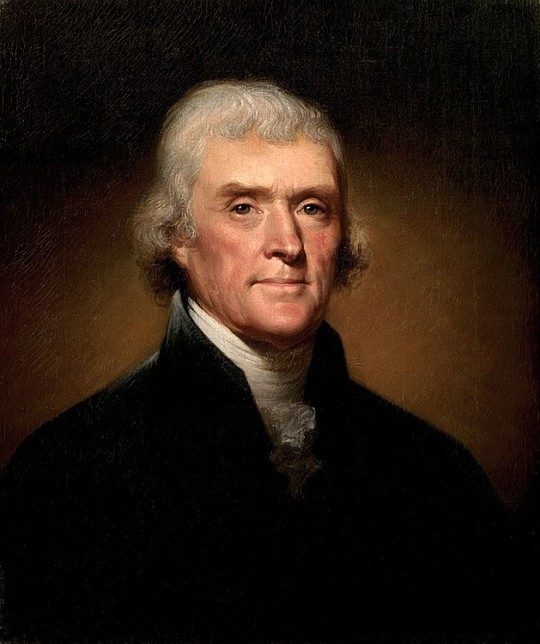
Thomas Jefferson
Thomas Jefferson (1743-1826) was an American lawyer, statesman, philosopher, and a Founding Father of the United States. A prominent figure of the American Revolution, he wrote the Declaration of Independence and later served as the first secretary of state, the second vice president, and the third president of the United States (served 1801-1809).
Early Life
Thomas Jefferson was born on 13 April 1743 at Shadwell Plantation in Albemarle County, Virginia. He was the third of ten children born to Peter Jefferson, a wealthy planter and land surveyor, and Jane Randolph Jefferson, a daughter of one of Virginia's most influential families. When Peter Jefferson died in 1757, 14-year-old Thomas inherited 5,000 acres of land as well as 60 enslaved people. From 1758 to 1760, he was privately tutored by Reverend James Maury before going on to the colonial capital of Williamsburg to attend the College of William & Mary. In his first year at college, he spent lavishly on parties, horses, and clothing, but he would soon regret this "showy style of living" (Boles, 18). His second year, therefore, was much more studious; he would apparently spend 15 hours a day at his studies, pausing only to exercise or to practice his violin.
The studious Jefferson soon became the protégé of mathematics professor William Small, who he would fondly remember as "the first truly enlightened or scientific man" he had ever met (Boles, 17). Small introduced Jefferson to the two other great intellectuals in Williamsburg – law professor George Wythe and Lt. Governor Francis Fauquier – and, at their weekly dinner parties, the four men would discuss politics and philosophy, greatly influencing the young Jefferson's political and intellectual development.
After completing his formal studies in 1762, Jefferson remained in Williamsburg to study law under Wythe and was admitted to the Virginia bar five years later in 1767. In 1768, he was elected to the House of Burgesses, representing Albemarle County. That same year, he began construction of a new home atop an 868-foot-high (265 m) mountain that overlooked his plantation. Called Monticello – Italian for "little mountain" – the house became the passion of Jefferson's life, and he would spend the next several decades designing and renovating it. The actual labor, of course, was mostly performed by his slaves; over the course of his lifetime, Jefferson owned approximately 600 enslaved people, most of whom were born into slavery on his property.
In 1772, after several failed romantic pursuits, Jefferson was finally married to the beautiful young widow Martha Wayles Skelton. Five years his junior, Martha shared his passions for literature and music; indeed, they often played music together – she on the harpsichord, he on the violin. The couple would have six children, only two of whom – Martha 'Patsy' (1772-1836) and Mary 'Polly' (1778-1804) – would survive to adulthood. When Jefferson's father-in-law died in 1773, he and Martha inherited 11,000 acres of land and 135 more enslaved people. By then, Jefferson had become involved with Virginia's struggle against Great Britain. Parliament's attempts to tax the colonists without their consent were vehemently opposed by the American Patriots, who saw such taxes as violations of their 'rights as Englishmen'. In 1774, Jefferson argued as much in his A Summary View of the Rights of British America. In it, he asserted that the colonies had the right to govern themselves, that they were tied to the English king only through voluntary bonds and that Parliament had no right to interfere in their affairs. This work earned him recognition as a Patriot leader in Virginia and led to his appointment as a delegate to the Second Continental Congress in Philadelphia in the spring of 1775.
Continue reading...
23 notes
·
View notes
Text
Americans [...] would sip the rich cocoa as a hot drink. Cocoa made its way to North America on the same ships that transported rum and sugar from the Caribbean and South America [...] and was heavily reliant on the labor of enslaved Africans throughout the diaspora. [...] [B]y the early 1700s, Boston, Newport, New York and Philadelphia were processing cocoa into chocolate to export and to sell domestically. Chocolate was popular in the coffeehouse culture and was processed for sale and consumption by enslaved laborers in the North. Farther south, in Virginia, cocoa was becoming [...] so popular that it is estimated that approximately one-third of Virginia’s elite was consuming cocoa in some form or another. For the wealthy, this treat was sipped multiple times a week; for others it was out of reach. [...]
The art of chocolate-making – roasting beans, grinding pods onto a stone over a small flame – was a labor-intensive task. An enslaved cook would have had to roast the cocoa beans on the open hearth, shell them by hand, grind the nibs on a heated chocolate stone, and then scrape the raw cocoa, add milk or water, cinnamon, nutmeg or vanilla, and serve it piping hot.
---
One of the first chocolatiers in the Colonies was an enslaved cook named Caesar.
Born in 1732, Caesar was the chef at Stratford Hall, the home of the Lees of Virginia, and in his kitchen sat one of only three chocolate stones in the Colony. The other two were located at the governor’s palace and at the Carter family estate, belonging to one of the wealthiest families in Virginia. Caesar was responsible for cooking multiple meals a day for the Lees and any free person who came to visit. [...]
---
The work was oppressive in the plantation kitchens at Christmas time. [...]
[T]hose working in the big house kitchen and as domestic laborers were expected to work around the clock to ensure a perfect holiday for the white family. The biggest task at hand was to cook and serve Christmas dinner, and chocolate was a favorite addition to the three-course formal dinner. [...] Oyster stew, meat pies, roasted pheasant, puddings, roasted suckling pig and Virginia ham are some of the many dishes that would be served in just one course. The night would finish with the sipping of chocolate: toasted, ground and spiced [...] and served in sipping-cups made specifically for drinking chocolate. [...]
---
Decades before the two well-known enslaved chefs, Monticello’s James Hemings and George Washington’s Chef Hercules, [...] Caesar was running one of the Colonies’ most prestigious kitchens inside of Stratford Hall, and making chocolate for the Lees and their guests. [...] [H]is son, Caesar Jr., lived nearby and was the postillion [...].
The stress of cooking the most important dinner of the year was combined with the fear of what was to come on Jan. 1. New Year’s Day was commonly known as heartbreak day, when enslaved folks would be sold to pay off debts or rented out to a different plantation. Jan. 1 represented an impending doom, and the separation of families and loved ones. [...] Caesar disappeared from the records by the end of the 18th century. By 1800, his son Caesar Jr. was still owned by the Lees, but as that year ended, Christmas came and went, and Caesar Jr. was put up for collateral by Henry Lee for payment of his debts.
---
The world Caesar lived in was one fueled by the Columbian Exchange, which was built from enslaved labor [...]: pineapples, Madeira wine, port, champagne, coffee, sugar and cocoa beans. These items traveled from plantation to dining room via the Atlantic trade, and were central to securing the reputation of Virginia’s plantation elite. The more exotic and delicious the food, the more domestic fame one would reap. Having cocoa delivered directly to your home, and having a chocolatier in the kitchen, were exceptional. It was through Caesar’s culinary arts that Stratford Hall became well-known throughout Colonial Virginia as a culinary destination.
---
All text above by: Kelley Fanto Deetz. “Oppression in the kitchen, delight in the dining room: The story of Caesar, an enslaved chef and chocolatier in Colonial Virginia.” The Conversation. 21 December 2020. [Bold emphasis and some paragraph breaks/contractions added by me.]
347 notes
·
View notes
Text
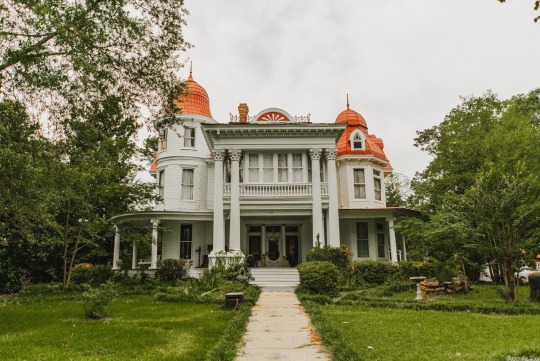
I can't believe that this 1906 stately home in Monticello, Arkansas is $488K. I would buy it so fast, b/c it's FULL of whimsy and fun. Look at the roof and architecture blending Queen Anne, Neoclassical, and Gothic elements. It has 4bds & 3ba.

This home has been featured on 5 TV shows and was the setting for a 2016 feature film. Several books have chapters featuring the house; it is the model for the house in the 1966 novel The Scent of Lilacs; and it is the sole subject of a bestselling nonfiction book published in 2012. Books and memorabilia are on display in the entry hall.

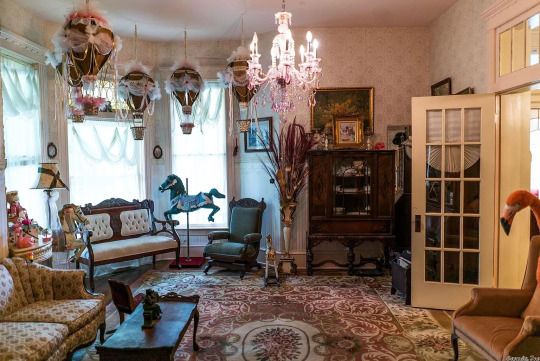
In the main sitting room off the hall, carousel horses prance, while fancy hot air balloons float above.
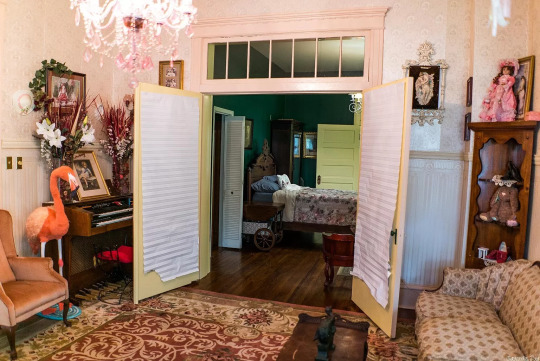

Across the hall is a deep green bedroom.
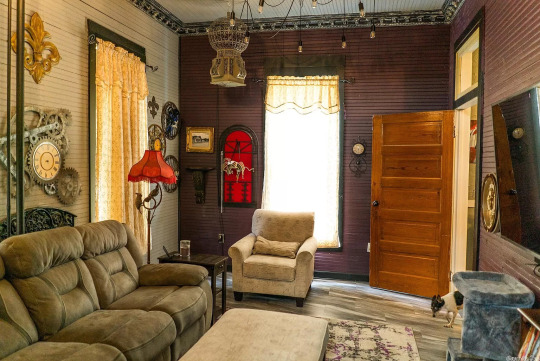
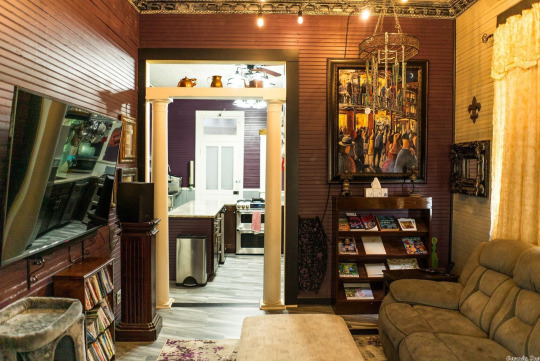
There's a family room with stick walls and whimsical decor off the kitchen.
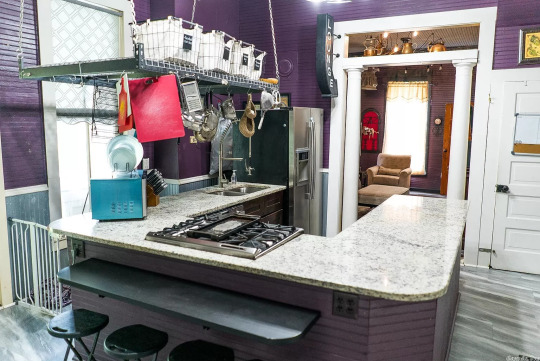

The kitchen also has stick walls and is painted in deep purple and gray. Look at the antique original sink in the corner.

There's also an original cupboard.
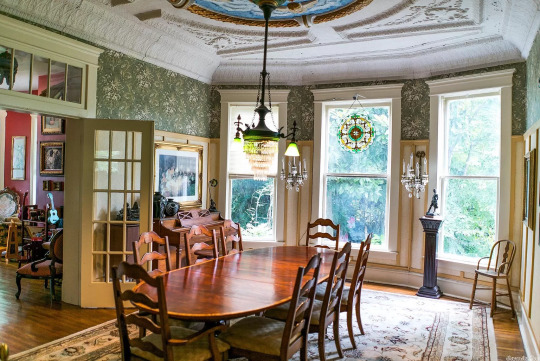

An ornate original ceiling has a painted medallion.
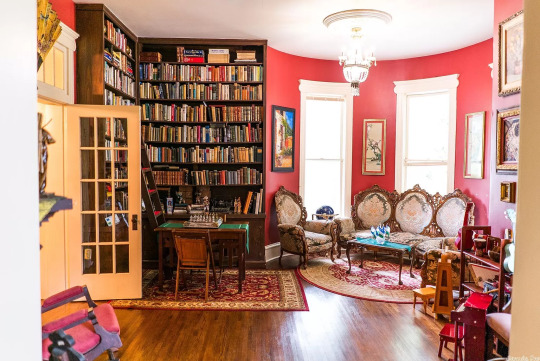

Lovely library with a corner desk, seating area and some antique toys.
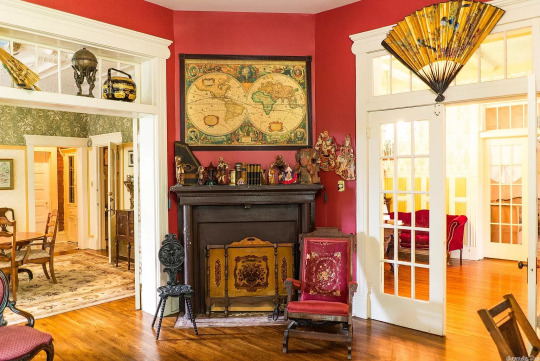
An original corner fireplace at the junction where 3 rooms meet.
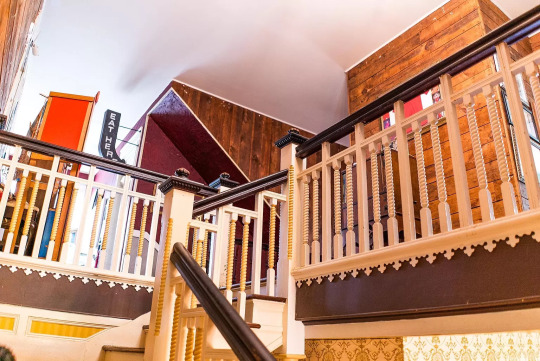

This upper level hall has a balcony and the room looks just like the center hall of a southern dog trot house with shiplap walls.

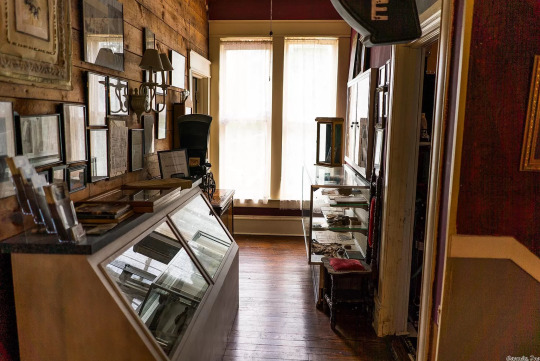
This is amazing- there's a little deli in the hall.
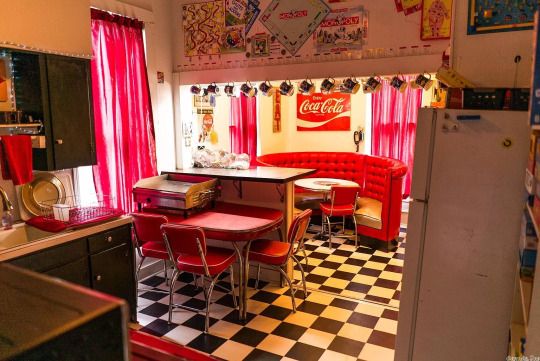

The "Eat Here" arrow sign directs you into this retro kitchen.
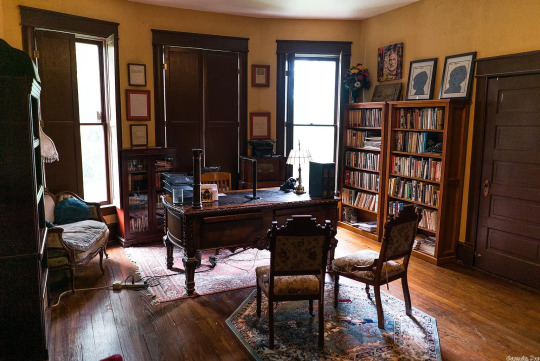
What a lovely home office.
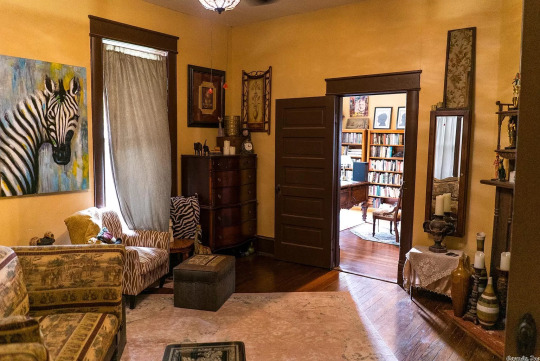

Next to the office is a safari themed room. How convenient to have your home office and bedroom together.

A bright red bath is reminiscent of New Orleans style.
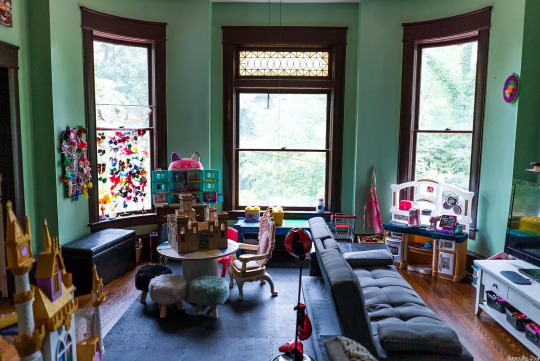
And, this is the playroom.
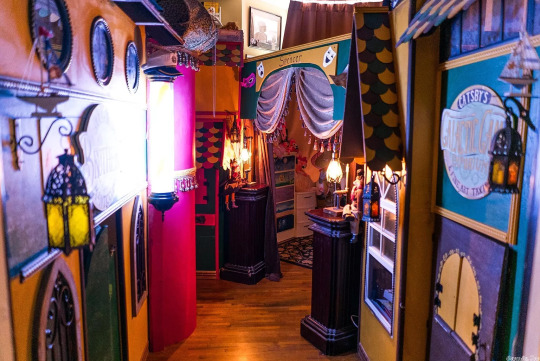
What a wonderful hallway. I feel like I'm in a fairytale.

Looking down at the sunny yellow entrance hall.
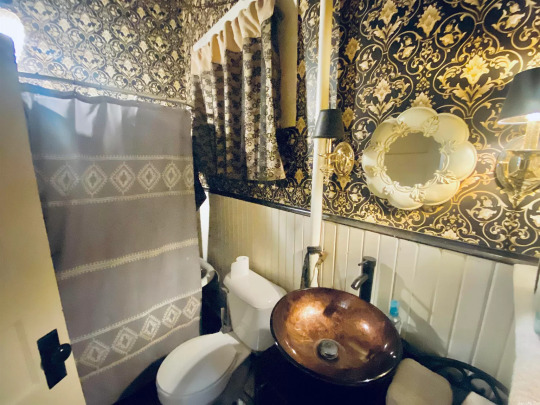
A small gold and black bath.
https://www.zillow.com/homedetails/705-N-Main-St-Monticello-AR-71655/90802610_zpid/
157 notes
·
View notes
Text

Redbud in Bloom
Richmond, Virginia (USA)
Based on a photo from March 26, 2023.
Eastern Redbud is shrub native to North America and a Spring favorite here in Virginia since colonial times. It is said that both George Washington and Thomas Jefferson admired Redbud trees out in the woods and planted them at their home estates (Mount Vernon, Monticello, Poplar Forest).
52 notes
·
View notes
Text
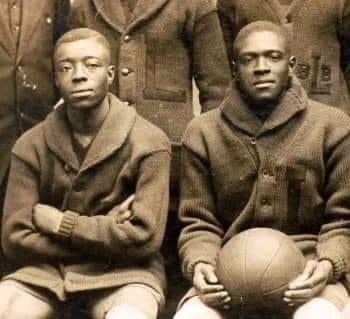
‘Pimp’ and ‘Lyss’: The Immortal Young Brothers by Claude Johnson (Black Fives Foundation)
They were brothers on and off the court. William Pennington Young, sometimes known as “Pimp” to his friends, and his older brother Ulysses S. Young, known simply as “Lyss” to his pals, were an unstoppable sibling pair of African American basketball stars that played during the 1910s and early 1920s.
They also made significant pioneering contributions off the court, long after their playing days ended.
Ulysses was born in Virginia in 1894. A year later, after his hard working parents migrated tot he North in pursuit of a better life, younger brother William was born in Orange, New Jersey.
A few years later, in 1900, their parents rented a room of their home to a young couple from Virginia, the Ricks family, who had a newborn son named James. Over the years the Young brothers embraced little James as if he were their own kin, and as the older boys got involved in sports, so did their protégé.
Something in that combined household created serious athletic skills.
Lyss and William attended nearby Orange High School, where they starred in football, basketball, and baseball. In 1910, while still in high school, the pair began playing semi-pro basketball for the Imperial Athletic Club, a local squad that competed against such teams as the Newark Strollers, the Montclair Athletic Club, and the Jersey City Colored YMCA. The two immediately received attention in the black sports press, including the popular and nationally circulated New York Age.
Their attraction to basketball got young James hooked on the sport too, and he soon developed his own talent. One huge advantage was having the opportunity to learn from- and train with the Young brothers.
The little basketball apprentice, James Ricks, would grow up to become James “Pappy” Ricks, who would become a founding member of the New York Renaissance Big Five professional basketball team and eventually reach the Naismith Basketball Hall of Fame.
After high school, the Young brothers attended Lincoln University in West Chester, Pennsylvania, which was not only America’s oldest historically black university but also was the closest to home for them. In college they both were once again three-sport stars. Though the brothers excelled in each sport, their first claim to fame was through football.
Playing quarterback, William was named as a Negro All-American during his senior year. Ulysses, playing end, was named to the Milton Roberts All Time Black College Football Squad for the 1910s Decade.
After graduating from Lincoln (“Pimp” was class valedictorian in 1917), the Youngs were recruited to play professional basketball in Pittsburgh by prominent African American sports promoter Cumberland Posey. Posey, historian Rob Ruck wrote in Sandlot Seasons, his landmark book that explores the city’s unique athletic heritage, “was,as much as any one man could be, the architect of sport in black Pittsburgh.”
The pioneering promoter had been cultivating Pittsburgh’s black basketball talent through his operation of several different squads in the city, most prominently the Monticello Athletic Association, since the early 1910s. But with America’s imminent entry into World War I and the resulting lack of resources, Posey decided to consolidate his best talent into one powerfully built team.
The result was the Loendi Big Five, a legendary combo that was sponsored and got its name from the Loendi Social & Literary Club, an exclusive African American social club in the the city’s predominantly black Hill District.
1921.
Adding the collegiate superstars from Lincoln not only helped Posey promote his new team but also sparked the Loendi Big Five’s domination of black basketball, with a dynasty that included four straight Colored Basketball World Championships from 1919 through 1923.
31 notes
·
View notes
Text
Top Features to Look for in a Monticello Home

When searching for a home in Monticello, it’s important to prioritize the features that best align with your lifestyle. Whether you’re looking for modern amenities, eco-friendly upgrades, or spacious living areas, Monticello’s real estate market has something for every buyer. Here’s a breakdown of the top features to consider for a new home in this beautiful community.
Spacious and Open Floor Plans
Homes with open, flexible layouts offer greater versatility, allowing you to adapt the space to suit your lifestyle needs. Whether you want room for entertaining, a growing family, or a home office, spacious homes with open floor plans create a welcoming atmosphere.
Large living areas perfect for gatherings or quiet time.
Flexible room layouts for multifunctional spaces.
High ceilings for an airy, open feel.
Energy-Efficient Features
With the growing demand for eco-friendly homes, Monticello offers several properties that feature energy-efficient upgrades. These can help save on utility bills while also reducing your carbon footprint.
Energy-efficient windows to reduce heating and cooling costs.
Smart thermostats that can be controlled remotely.
Solar panels for long-term energy savings.
Modern Kitchens and Baths

Kitchens and bathrooms are often the focal points of a home. Whether you enjoy cooking or simply appreciate a stylish space, modern finishes and top-of-the-line appliances will elevate your home’s appeal.
Quartz or granite countertops for a sleek, durable surface.
Energy-efficient appliances for better sustainability.
Updated bathroom fixtures for a more luxurious experience.
Smart Home Technology
As homes continue to evolve, smart technology has become a key feature for many buyers. Monticello homes equipped with smart home devices offer convenience, security, and efficiency.
Smart lighting systems to adjust ambiance remotely.
Voice-controlled assistants to manage your home’s functions.
Smart security systems for enhanced protection.
Click here to read more
#Monticello homes#buying a home#home features#energy-efficient homes#Monticello real estate#home layouts#smart home technology#outdoor living#family homes
0 notes
Text
My second day at Yorktown for Lafayette's bicentennial anniversary of his tour (as an American friends of lafayette member) part 2/? - IT'S YORKTOWN BRITISH SURRENDER DAY!!!
first I went on the bus provided to the French soldiers grave for a memorial and wreath laying
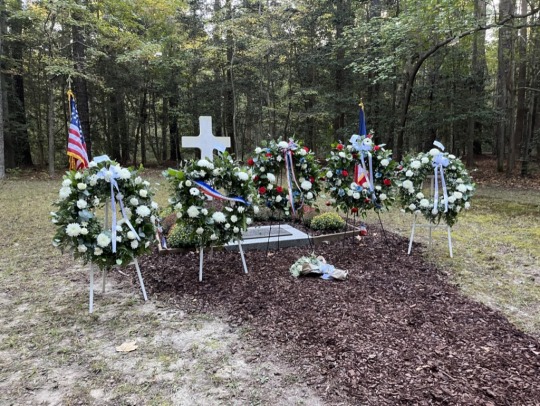
Then it's back on the buses to the French soldiers memorial plus more wreath laying

Then we went to the parade!!! I was there with the AFL, infact, I got to hold the big American flag! (mark schneider had the French one)

the parade is HUGE!!! the AFL is almost to the last and we waited for like 20 minutes PEOPLE JUST KEPT SPAWNING WTF!!!!

Then we went to the Yorktown monument for the 'patriotic exercises' (why they call it that?), a BEAUTIFUL reenactment of lafayette reunited with James Armistead Lafayette and some speeches! I actually met 2 direct decedents of James, it was SO COOL!!! I kinda learned in this 'patriotic exercises' if anyone mentions lafayette, i along with the rest of AFL start cheering sand yelling vive lafayette, every time benedict arnold mention, we boo him.
After that I got some ice cream in this place that have the best decorations

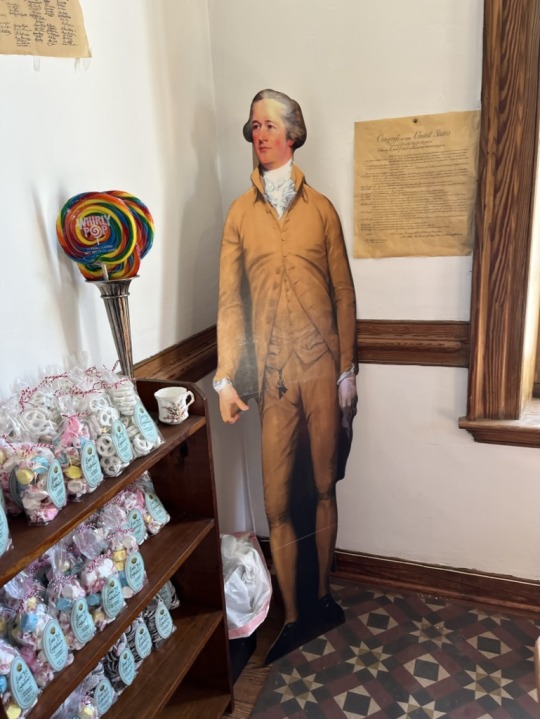



got some stuff
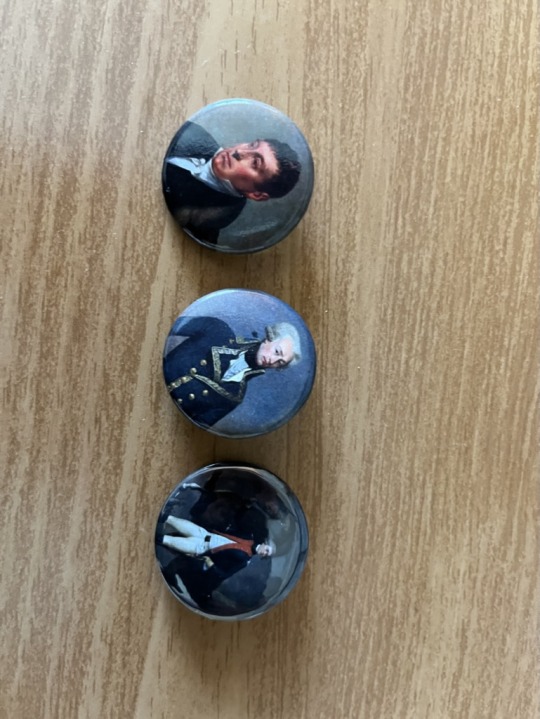

i also got a tour calendar, a tote bag and a shirt with basically left me bankrupt 🥲 BUT i always wanted these and online they are more expensive plus shipping so it's worth it!
At the end I went to the AFL member dinner and I even got to take home some wine bottles!
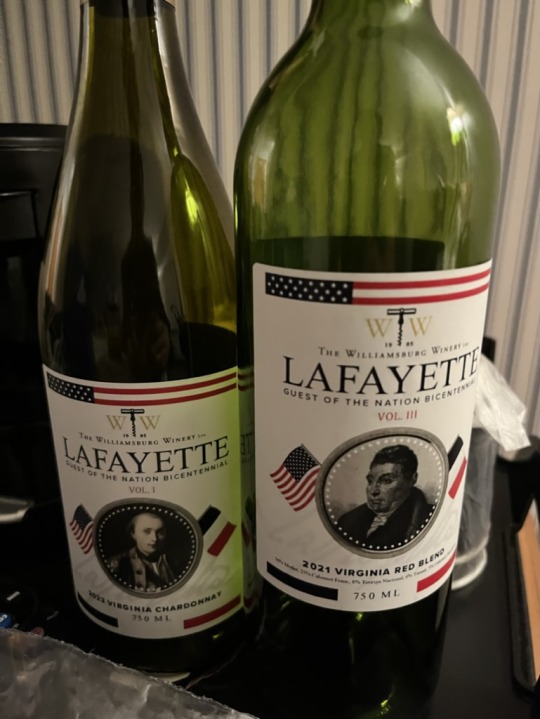
(i like to collect glass bottles and put random stuff and paint brushes in them) (i already have a colonial willamsburg and Montpelier(james madison house idk how to spell it) and one not glass bottle from monticello)
here is a post i made about my first day (welcome lafayette to yorktown) :)
once again HAPPY YORKTOWN DAY EVERYONE!!!! the battle that lead the colonies one step closer to independence
#lafayette’s farewell tour#lafayette farewelll tour#lafayettes farewell tour#yorktown#lafayette events#marquis de lafayette#mark schneider#yorktown day#amrev
12 notes
·
View notes
Note
Can you tell me everything you know about Martha Jefferson?
I would love to. In my opinion, Martha Wayles Skelton Jefferson is one of the most tragic figures of the 18th century, and her life shows the many challenges a woman would face in this time period, due to the incredible expectations put on them. I'd like to open by saying that the importance of discussing women in history not only gives us a more full perspective on any and every historical event, but it also gives light to less commonly discussed historical figures that were equally important that we don't know as much about. Martha Jefferson is undoubtably one of those people.
Martha Wayles was born on October 30, 1748 to her wealthy father. Her father was an English immigrant who moved to America and accumulated a decent fortune through slave trading, planting, and his law practice.
Content warning: mention of sexual assault within slavery, skip next paragraph if this may be distressing
Her father is a very interesting figure. In his law practice, he specialized in debt collections, which made him very unpopular among the locals. Additionally, he raped an enslaved woman on his property several times, Elizabeth Hemmings, after the death of his third wife. She would have several children by him, including Sally Hemmings, who would later be raped and have several children by Thomas Jefferson. It is disgusting, but crucial to mention that because of the slave system in America, and the violation of African American women, Martha Jefferson was the half sister of Sally Hemmings.
Martha married Bathurst Skelton when she was 18. They would have one child, John, who died in infancy. Her first husband died six months before Jefferson married Martha, and her first child with Jefferson, Martha aka Patsy, would come nine months after Martha's first child. Her almost constant pregnancy and troubles in maternity would eventually lead to her death.
She married the very eligible bachelor Thomas Jefferson on New Years Day, 1772 at her plantation home, "The Forest". There was a five year age gap between them, as she was 22 going on 23, and he was 28. Jefferson would actually scarcely mention her first husband, and would even report false information that he did not exist, that Martha was a spinster when he married her. The motivations for this are not confirmed.
The young couple arrived at Jefferson's home, Monticello, during a snowstorm, where all the servants were asleep and the house was cold. They toasted their marriage with a leftover bottle of wine, and entered into a period of domestic happiness.
Martha and Thomas had complimentary personalities, balancing out each other's characteristics. They shared an interest in music, as Jefferson played the violin or the cello, and Martha played the piano or the harpsicord. She was said to be very talented.
While there is no known portraits of her, she was described as very beautiful and accomplished. She was slim with hazel eyes and auburn hair. She was the subject of frequent praise from all that knew her.
The Jeffersons had five children in ten years, but only two would survive to adulthood, Martha (Patsy) and Mary (Polly or Mary). Martha was under such strain from her frequent pregnancies that she fell very ill in 1781. The British had invaded Richmond, which forced her away from her husband back to Monticello, but Jefferson often left his political career to stay with her during her sickness. The British would raid Monticello, forcing her to travel in her poor condition yet again.
Her condition continued to worsen, until she died on September 6, 1782, at 11:45 AM at the age of 33. Jefferson would never record his relationship with her, so her life remains mostly a mystery among historians.
Martha Jefferson was far more than the deceased wife of the third president. During her life, she was the mother of several children, who frequently had to grieve their deaths. She was the mistress of a fashionable household, and the wife of an energetic, young politician who was making strides in the cause of liberty and American independence. Her life was riddled with tragedy and mourning, but she was a lively, creative woman who had an untimely death at a cruel age.
#american history#history#amrev#martha jefferson#martha wayles skelton jefferson#amrev history#asks#thomas jefferson#women's history#18th century#1700s
32 notes
·
View notes
Text
Plano Police report wife killed husband on Monticello Drive on Saturday night
Police report Plano Police have arrested a woman in the 2300 block of Monticello Circle, in 75075 Zipcode between 15th Street and Park Blvd., near Greenway Drive west of Custer Road. The 9-1-1 call came in about 10:35 p.m. Saturday. Plano Police arrived and discovered the man who had called 9-1-1 suffering from a gun shot. A little later, Plano Fire and Rescue reported he had died after being…

View On WordPress
#Husband shot by wife in Plano TX Home on Monticello#Plano domestic dispute ends in wife shooting husband#Wife shoots husband in Plano TX
0 notes
Photo

Sleep Clinic of Arkansas
Drew Memorial’s Sleep Center diagnoses and treats sleep disorders, from the common Obstructive Sleep Apnea (OSA), to the more rare REM Behavior Disorders. Sleep apnea is the most common sleep disorder, and its side effects include high blood pressure, heart disease, and congestive heart failure. Symptoms to look for include daytime sleepiness/fatigue, increased irritability, snoring, witnessed apnea, difficulty staying awake, difficulty concentrating, and frequent awakening during sleep. For more details visit: Sleep Clinic of Arkansas
0 notes